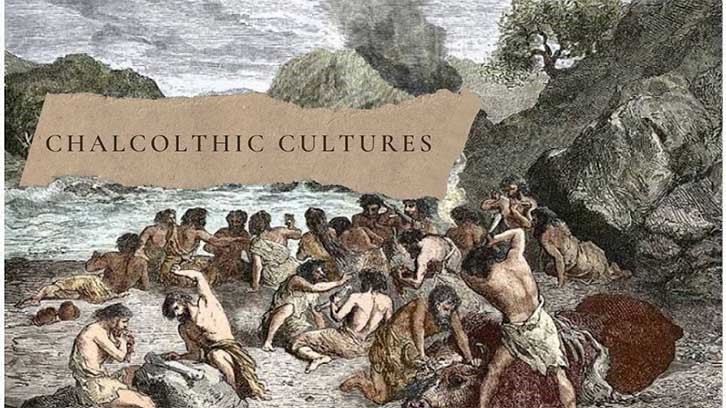COPPER AGE

Disclaimer: Copyright infringement not intended.
Context
- Ancient human genomic data analysis suggests that the interaction between Copper Age farmers and steppe pastoralists might have occurred 1,000 years earlier than previously believed.
Details
Genetic Turnover Events in Western Eurasia
- Previous genomic analyses have identified two major genetic turnover events in Western Eurasia:
- The first event linked to the spread of farming around 7,000-6,000 BC, where agricultural practices and settled communities expanded.
- The second event resulted from the expansion of pastoralist groups from the Eurasian steppe around 3,300 BC.
Characteristics of the Copper Age
- The Copper Age was a transitional period between the Neolithic Age and the Bronze Age.
- It was characterized by the emergence of metallurgy, where copper and other metals began to be used alongside stone tools.
- Other notable developments during this period included wheel and wagon transportation and the domestication of horses.
Unexplained Period Between Copper Age and Pastoralist Expansion
- The period between the demise of Copper Age settlements (around 4,250 BC) and the expansion of pastoralist groups (around 3,300 BC) remains poorly understood.
- Researchers have yet to uncover the specific reasons and mechanisms behind this transition and interaction between the two groups.
Significance of the Findings
- The new findings may offer valuable insights into the dynamics of ancient human interactions and migrations.
- Understanding the earlier interactions between Copper Age farmers and steppe pastoralists can shed light on the demographic and cultural changes that shaped the region during that time.
Implications for the Demise of the Copper Age
- The earlier interaction between these groups may have played a role in the decline of the Copper Age settlements, but the exact nature of this influence is yet to be determined.
- Factors such as competition for resources, cultural exchanges, or conflicts might have contributed to the changes during this transitional period.
Impact on Pastoralist Expansion
- The genomic data indicating earlier interactions may also have implications for understanding the factors that facilitated the expansion of pastoralist groups.
- Interactions with settled communities during the Copper Age might have influenced the pastoralists' movements and strategies for expansion.
Copper Age Overview
Timeline
- The Copper Age generally spanned from around 4500 BC to 3300 BC, though the dates can vary in different regions.
Metallurgy Advancements
- One of the most significant developments during the Copper Age was the discovery and use of copper for various tools and ornaments.
- Early metallurgists learned to smelt and shape copper into tools, weapons, and decorative items.
Technological Innovations
- The Copper Age saw advancements in pottery, weaving, and other crafts.
- The wheel and wagon transportation emerged during this period, facilitating trade and transportation of goods.
Agriculture and Settlements
- Agriculture continued to be the primary mode of subsistence, with communities growing crops and raising livestock.
- Settlements became more permanent, leading to the establishment of early urban centers.
Social and Cultural Developments
- With settled communities, social structures became more complex, and a division of labor emerged.
- Artifacts from this period indicate an increase in trade and cultural exchanges between different regions.
Religious and Artistic Expressions
- The Copper Age people practiced religious rituals, as evidenced by burial sites and artifacts associated with ritual practices.
- Artistic expressions, such as pottery designs and figurines, reflect the beliefs and cultural practices of the time.
Decline and Transition
- The Copper Age came to an end with the advent of the Bronze Age, characterized by the use of bronze, an alloy of copper and tin.
- The transition to the Bronze Age marked a significant advancement in metalworking technology and brought about further changes in societies.
Legacy
- The Copper Age laid the foundation for the subsequent Bronze Age, where metal tools and weapons became even more prevalent.
- The knowledge and experience gained during the Copper Age paved the way for further technological progress and cultural development in human history.
Conclusion
Ongoing research and discoveries continue to add to our understanding of the Copper Age and its significance in the broader context of human development. In conclusion, the Copper Age played a crucial role in human history as a transitional phase that witnessed significant advancements in technology, metallurgy, and societal organization. The adoption of copper for tools and the emergence of settled communities set the stage for further progress in the Bronze Age. Studying the Copper Age helps us comprehend the cultural, technological, and economic changes that shaped early human societies and laid the groundwork for future civilizations.
|
PRACTICE QUESTION Q. How did metallurgy, technological innovations, and social developments during the copper age period pave the way for further advancements in the Bronze Age? Support your answer with relevant examples and archaeological evidence. (150 Words) |





1.png)
